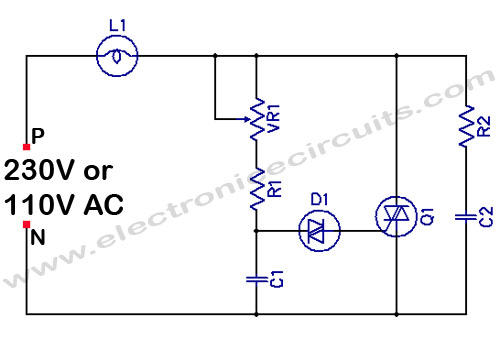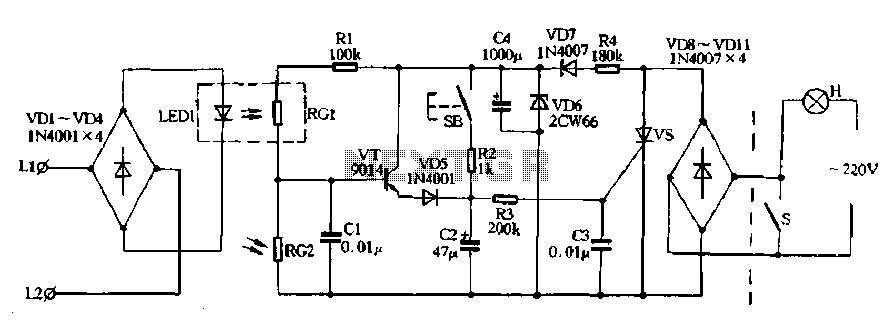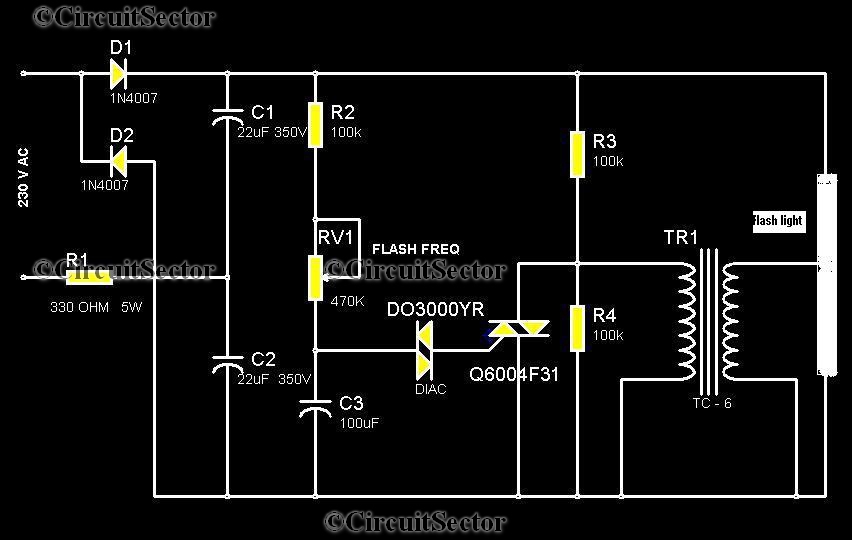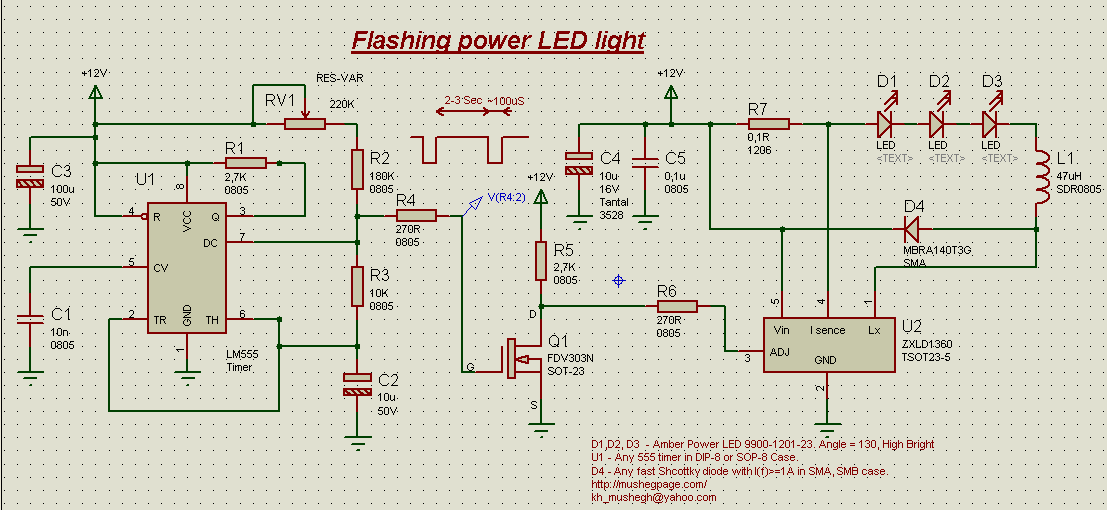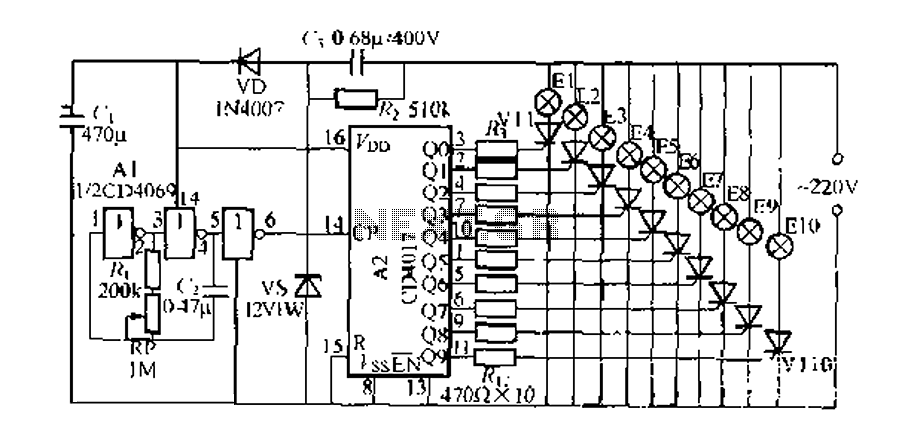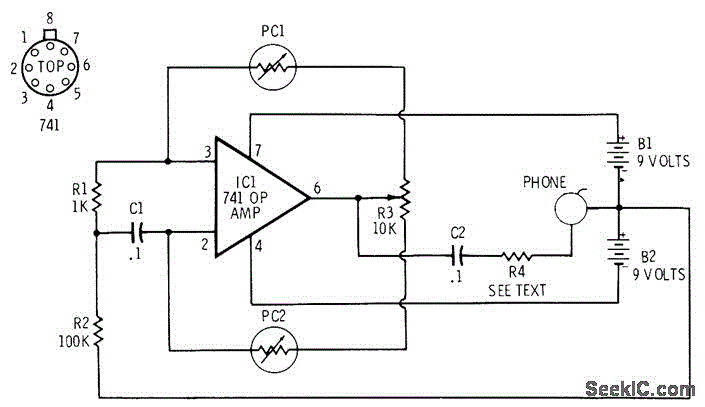
Automatic White-LED Garden Light
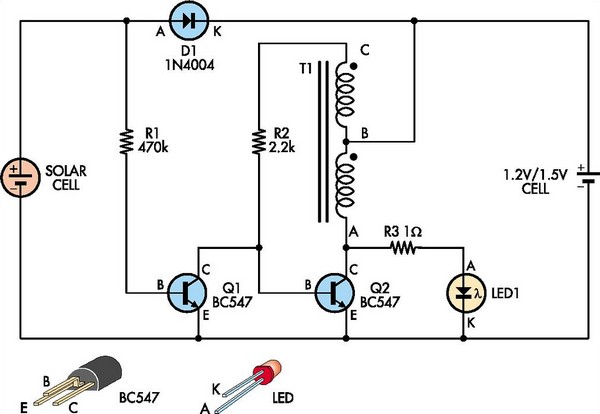
This white LED driver circuit is suitable for garden lighting applications. It automatically activates the LED at night and operates from a single 1.2V NiCad cell, which is recharged by a solar cell during the day. The prototype utilized the existing casing and solar cell from an old garden light, but a solar cell from a solar education kit could also be employed. Diode D1 allows the solar cell to charge the battery during the day while preventing discharge back into the solar cell at night. Transistor Q1 regulates the LED driver circuit. It remains on during the day (when there is output from the solar cell), keeping Q2 and the LED off. At night, Q1 turns off, enabling a simple blocking oscillator circuit formed by T1, R2, and Q2 to operate. This circuit drives LED1 through a 1W resistor that limits the peak current to the LED. T1 is wound bifilar, with two windings configured to create a center-tapped winding. Winding AB serves as the primary winding, while winding BC acts as the feedback winding. The turns count and core type are not critical; the prototype functioned with a toroid salvaged from an old computer power supply, as well as a small ferrite suppression bead and an Altronics L5110 core. The toroids were wound with 10 turns of 0.25mm wire, while the ferrite bead accommodated just five turns of 0.25mm wire through its hole. The oscillator operates as follows: when Q1 turns off, current flows through R2, turning Q2 on. This allows current to flow through winding AB, generating magnetic flux in the core. Consequently, the voltage at end C of the transformer rises above the battery voltage, driving Q2 into saturation. Once the core saturates, the voltage at C returns to the battery voltage, reducing the current in winding AB. As this occurs, the magnetic flux in the core decreases, causing the voltage at C to drop below 0.6V, which results in Q2 turning off. With no current in winding AB, the magnetic flux collapses. The voltage at end A of the windings then exceeds the battery voltage. When it reaches 3.2-3.6V with respect to ground, LED1 activates, allowing current to flow from the battery through winding BA, through the LED, and back to the battery. When the magnetic flux is depleted, LED1 turns off, and the voltage at end C returns to the battery voltage. Current then flows through R2 into the base of Q2, restarting the cycle. When sunlight returns the following morning, Q1 turns on, cutting off Q2's base drive, halting the oscillation, and turning off LED1.
The circuit operates efficiently in a self-sustaining manner, leveraging the solar cell's energy to power the LED during nighttime conditions. The use of a NiCad battery ensures reliable performance, even in low-light conditions. The diode D1 is crucial for preventing backflow of current, thus protecting the solar cell and ensuring that the battery remains charged. The blocking oscillator configuration allows for effective energy transfer from the battery to the LED, while the feedback mechanism ensures that the LED is driven only when necessary, maximizing battery life.
The design also incorporates flexibility in the choice of components, as demonstrated by the successful use of various cores and winding configurations. This adaptability allows for optimization based on available materials and desired performance characteristics. The circuit's simplicity and reliance on basic electronic components make it an excellent choice for DIY enthusiasts and educational projects, promoting an understanding of solar energy utilization in practical applications.This white-LED driver circuit is ideal for use in a garden light. It automatically turns the LED on at night and runs from a single 1. 2V nicad cell which is recharged by a solar cell during the day. The prototype used the existing casing and solar cell from an old garden light but you could also use a solar cell from a solar education kit. Diode D 1 allows the solar cell to charge the battery during the day and prevents it from discharging back into the solar cell at night. Transistor Q1 controls the LED driver circuit. This transistor is normally on during the day (ie, when there is output from the solar cell) and so Q2 and the LED are off.
At night time, Q1 is off and this allows a simple blocking oscillator circuit based on T1, R2 and Q2 to operate. This circuit in turn drives LED1 via a 1W resistor which limits the peak current into the LED. T1 is wound bifilar, with the two windings configured to produce a center-tapped winding. Winding AB is the main primary winding and winding BC is the feedback winding. The number of turns and the core used are not critical. The prototype worked with a toroid scrounged from an old computer power supply, as well as with a small ferrite suppression bead and an Altronics L5110 core.
The toroids were wound using 10 turns of 0. 25mm wire, while the ferrite bead worked with just five turns of 0. 25 mm wire through the hole (that`s all that would fit). The oscillator works like this: when Q1 turns off, current flows through R2 and turns Q2 on. This causes current to flow through winding AB and the core produces a magnetic flux. And that in turn causes end C on the transformer to rise above the battery voltage and turn Q2 on hard. When the core saturates, the voltage at C drops back to the battery voltage, thus reducing the current in winding AB.
As this happens, the flux in the core starts to fall and this causes the voltage at C to drop below 0. 6V. As a result, Q2 turns off and because there is now no current in AB, the flux in the core starts to collapse.
What happens now is that the voltage on end A of the windings rises above the battery voltage. When it gets to 3. 2-3. 6V with respect to ground, LED1 "fires" and current flows from the battery via BA, through the LED and back to the battery. When the flux is spent, LED1 turns off and end C returns to the battery voltage. Current now flows through R2 and into the base of Q2 and the whole cycle starts over again. Finally, when the Sun rises the following morning, Q1 turns on, robs Q2 of its base drive, the oscillation stops and LED1 goes out.
🔗 External reference
The circuit operates efficiently in a self-sustaining manner, leveraging the solar cell's energy to power the LED during nighttime conditions. The use of a NiCad battery ensures reliable performance, even in low-light conditions. The diode D1 is crucial for preventing backflow of current, thus protecting the solar cell and ensuring that the battery remains charged. The blocking oscillator configuration allows for effective energy transfer from the battery to the LED, while the feedback mechanism ensures that the LED is driven only when necessary, maximizing battery life.
The design also incorporates flexibility in the choice of components, as demonstrated by the successful use of various cores and winding configurations. This adaptability allows for optimization based on available materials and desired performance characteristics. The circuit's simplicity and reliance on basic electronic components make it an excellent choice for DIY enthusiasts and educational projects, promoting an understanding of solar energy utilization in practical applications.This white-LED driver circuit is ideal for use in a garden light. It automatically turns the LED on at night and runs from a single 1. 2V nicad cell which is recharged by a solar cell during the day. The prototype used the existing casing and solar cell from an old garden light but you could also use a solar cell from a solar education kit. Diode D 1 allows the solar cell to charge the battery during the day and prevents it from discharging back into the solar cell at night. Transistor Q1 controls the LED driver circuit. This transistor is normally on during the day (ie, when there is output from the solar cell) and so Q2 and the LED are off.
At night time, Q1 is off and this allows a simple blocking oscillator circuit based on T1, R2 and Q2 to operate. This circuit in turn drives LED1 via a 1W resistor which limits the peak current into the LED. T1 is wound bifilar, with the two windings configured to produce a center-tapped winding. Winding AB is the main primary winding and winding BC is the feedback winding. The number of turns and the core used are not critical. The prototype worked with a toroid scrounged from an old computer power supply, as well as with a small ferrite suppression bead and an Altronics L5110 core.
The toroids were wound using 10 turns of 0. 25mm wire, while the ferrite bead worked with just five turns of 0. 25 mm wire through the hole (that`s all that would fit). The oscillator works like this: when Q1 turns off, current flows through R2 and turns Q2 on. This causes current to flow through winding AB and the core produces a magnetic flux. And that in turn causes end C on the transformer to rise above the battery voltage and turn Q2 on hard. When the core saturates, the voltage at C drops back to the battery voltage, thus reducing the current in winding AB.
As this happens, the flux in the core starts to fall and this causes the voltage at C to drop below 0. 6V. As a result, Q2 turns off and because there is now no current in AB, the flux in the core starts to collapse.
What happens now is that the voltage on end A of the windings rises above the battery voltage. When it gets to 3. 2-3. 6V with respect to ground, LED1 "fires" and current flows from the battery via BA, through the LED and back to the battery. When the flux is spent, LED1 turns off and end C returns to the battery voltage. Current now flows through R2 and into the base of Q2 and the whole cycle starts over again. Finally, when the Sun rises the following morning, Q1 turns on, robs Q2 of its base drive, the oscillation stops and LED1 goes out.
🔗 External reference
